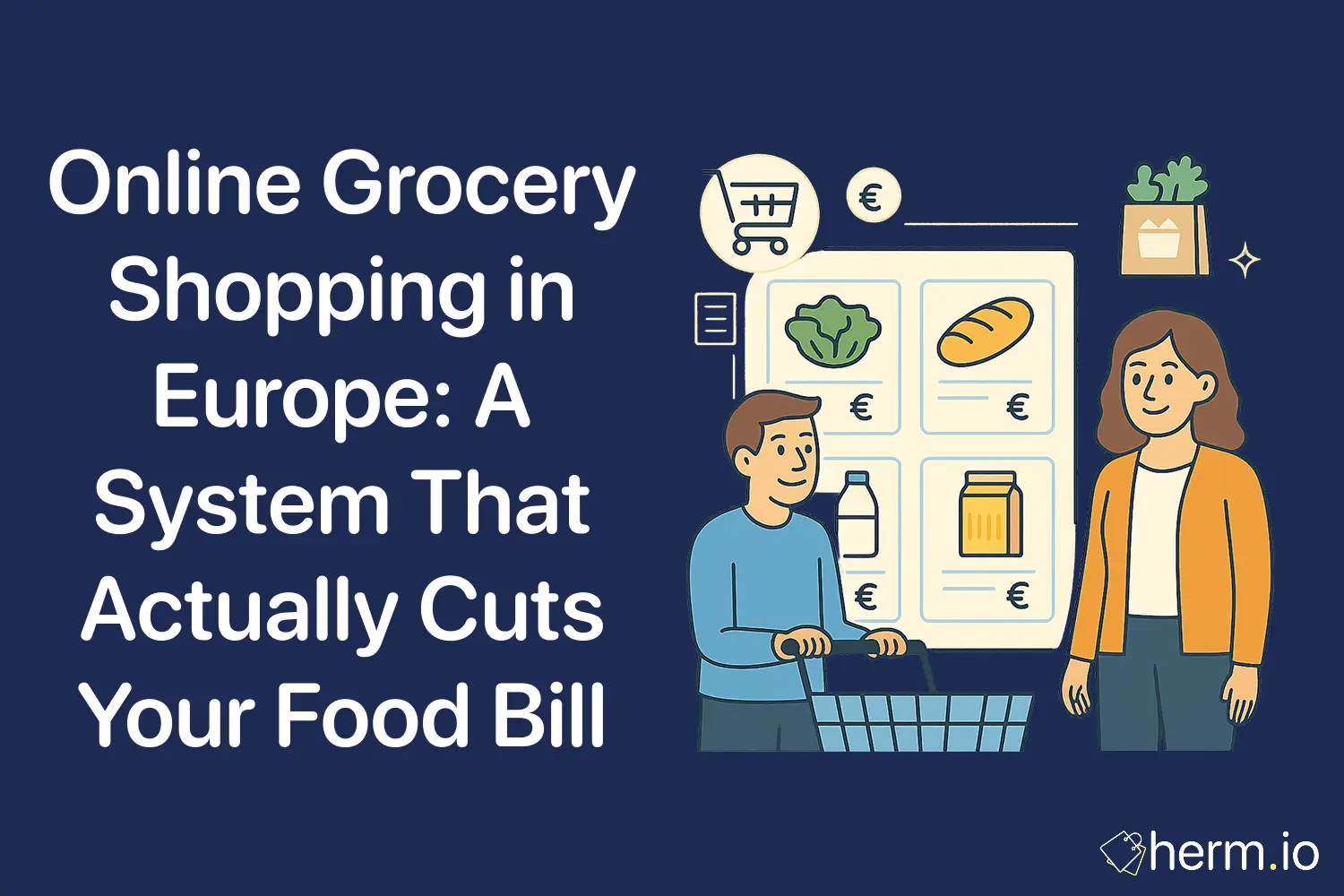
Most people treat online grocery shopping as occasional convenience. That's leaving money on the table.
The real savings appear when you stop hunting for one-off deals and start running a system instead: standardised baskets, predictable ordering cycles, and clear criteria for switching retailers. This approach makes your spending visible, your choices repeatable, and your food costs controllable.
Here's how to transform online grocery shopping in Europe from a convenience into a genuine budget tool.
Quick Wins: Start These Today
- Compare your regular basket across 2-3 services using the same 15 items—you'll spot £20-40 monthly differences immediately
- Calculate your delivery pass break-even point (pass cost ÷ typical delivery fee); if you order 3+ times monthly, the pass usually pays for itself
- Portion and freeze proteins the day they arrive—flat bags defrost faster and stack efficiently
- Add one ethnic grocery order quarterly for spices, sauces, and staples; authentic ingredients often cost 30-50% less than supermarket versions
Compare Services on What Actually Matters
Delivery fees get attention, but substitution policies, freshness standards, and refund processes affect your costs more than a £2 fee difference.
Fee structures and basket minimums
Check where your typical weekly spend lands. If you regularly hit £60-80, many retailers drop or reduce delivery fees at those thresholds. Paying attention to these tiers saves more than chasing the lowest base fee.
Minimum order requirements matter for smaller households. A £40 minimum forces unnecessary purchases; a £25 threshold feels realistic for one or two people.
Cut-off times and delivery windows
Late cut-offs (22:00 vs 18:00) give you flexibility to order after work without rushing. Flexible delivery windows cost less than one-hour slots; if your building has secure delivery options, choose the cheaper windows and redirect those savings into actual food.
Substitution rules drive waste or savings
Can you disable substitutions for critical ingredients? Does the app auto-refund price differences? These details prevent frustration and wasted money. Use the comments box strategically: "bananas slightly green" or "milk with longest date" typically gets you exactly what you need.
Track freshness systematically
Rate your deliveries consistently: firm produce, long-dated dairy, solid frozen items. If a service repeatedly delivers tired vegetables or short-dated milk, switch—the money you lose to waste exceeds any fee savings. Best services let you photograph issues and credit your account immediately.
Your evaluation framework
Create a comparison basket: milk, eggs, yogurt, chicken thighs, pasta, rice, onions, bananas, apples, tomatoes, potatoes, salad greens, bread, tinned beans, olive oil. Same 15 items across 2-3 services.
Record total cost, delivery fee, substitution flexibility, cut-off time, and your freshness rating (1-5). Choose your main service and keep one backup for stock shortages or targeted promotions.
This takes 20 minutes once; it saves you £30-50 monthly.
Subscriptions That Actually Break Even
Delivery passes and loyalty programmes sound appealing until you calculate whether you'll use them enough to matter.
Delivery pass mathematics
The break-even calculation is simple: pass cost ÷ average delivery fee = deliveries needed monthly.
Example: £9.99 pass ÷ £3.99 delivery = 2.5 deliveries. Round up to 3. If you order 3+ times monthly, the pass saves money. If you order twice monthly, you're losing £2 monthly for convenience that costs you money.
The hidden benefit: passes let you split large orders into smaller ones without penalty. This reduces waste because you're not buying a week's worth of lettuce that goes limp by Thursday.
Loyalty cards done properly
Member prices on proteins and dairy typically save £4-8 weekly. Birthday bonuses and targeted coupons add another £5-10 monthly. The cashback at month-end often reaches £8-15 if you're already spending £200-300 monthly on groceries.
Activate these cards; ignore the promotional noise. You want member pricing, not encouragement to buy things you don't need.
Banking and telecom bundles
Some credit cards offer 2-5% cashback at supermarkets. Mobile plans occasionally include grocery perks. Check what you already have before paying for additional benefits.
Stacking without overspending
Standard stack: delivery pass (free delivery) + loyalty card (member pricing) + cashback card (2-5% return). This combination works when you maintain a fixed weekly basket and resist the temptation to order more "because delivery is free."
Set price-drop alerts only for staples. Disable everything else—the goal is predictable spending, not reactive buying.
Bulk Buying Without the Waste
Bulk purchasing reduces unit costs significantly, but only if you actually use what you buy. The solution: align bulk orders with freezer capacity and plan simple "rescue" preparations for items approaching expiry.
What to bulk intelligently
Proteins offer the clearest savings. Chicken thighs, minced beef, fish fillets—portion immediately into meal-sized amounts (300-500g), vacuum-seal or use zip bags, freeze flat. Flat freezing speeds defrosting and maximises freezer space.
Fermented dairy lasts well. Yogurt portions freeze successfully; hard cheeses can be grated and frozen. UHT milk, tinned tomatoes, beans, chickpeas, and coconut milk store at room temperature indefinitely.
Produce with stamina—onions, potatoes, carrots, cabbage, apples, citrus—handles bulk buying. Frozen vegetables often cost less than fresh and eliminate prep waste.
What not to bulk
Tender herbs, salad greens, and soft berries need consumption within 3-4 days. Buy these for immediate use or freeze as purées when appropriate. Fresh bakery items don't freeze as well as sliced bread; treat them as current-week purchases.
Your freezer as a savings account
Label everything with contents and date. Portion by meal (2-4 servings). Stack flat bags like files. Keep a freezer inventory—a sticky note on the door prevents buying duplicates.
First In, First Out: newest stock goes to the back. This habit alone eliminates most freezer waste.
Rescue recipes prevent loss
Near-expiry vegetables: tray bake at 200°C with olive oil and salt, or throw into a frittata. Soft fruit: compote, smoothie packs, or quick muffins. Stale bread: breadcrumbs, croutons, bread pudding.
These five-minute solutions turn potential waste into actual meals.
Ordering rhythm that works
Weekly shop: fresh dairy, produce, bread, immediate needs. Monthly bulk order: proteins, frozen vegetables, UHT goods, household items.
This pattern smooths your spending and eliminates panic orders that cost 20-30% more than planned shopping.
Meal Kits as Tools, Not Permanent Solutions
Meal kits cost more per portion than cooking from scratch, but they save money when they replace takeaways (£15-20) rather than your regular groceries (£3-5 per portion).
When kits make financial sense
A £7-9 kit portion beats a £15 takeaway. That's a £6-8 saving per meal. Use kits strategically during busy weeks when you'd otherwise order delivery.
Better: use kits for 2-3 weeks to learn techniques and flavour combinations, then recreate those recipes using your own cheaper ingredients. This converts a £9 meal into a £4 meal while keeping the variety and satisfaction.
Reduce kit costs
Family-size plans drop per-portion pricing. Leftovers become tomorrow's lunch. Skip weeks when your freezer is well-stocked—most European services let you pause with a tap.
Use kit sauces and methods but substitute proteins from your bulk freezer stock. This cuts costs by 30-40% while keeping the convenience.
Avoid the upsells
Desserts, premium proteins, and snacks inflate kit bills quickly. Decline add-ons unless they genuinely replace something you'd buy anyway.
Europe's Ethnic Grocery Advantage
Online ethnic groceries offer authentic ingredients at significantly better prices than mainstream supermarkets charge for the same items. Within the EU, you typically avoid import duties; shipping costs matter, so order strategically.
Shop smart across borders
Prioritise shelf-stable goods: spices, sauces, noodles, dried beans, specialty pastes. Order chilled or frozen items only from shops with proper cold packaging.
Check label language—reputable shops display ingredients and allergen information in readable languages, plus country of origin.
Value-boosting staples
Whole spices last longer than ground versions; toast and grind small amounts as needed. Base sauces and pastes (curry pastes, gochujang, harissa, ajvar) transform cheap vegetables and proteins into satisfying meals.
Noodles and alternative grains (udon, rice noodles, bulgur, couscous, polenta) add variety without increasing spending. Dried beans and lentils offer maximum nutrition per pound spent.
Authentic without overspending
Restaurant-size packaging (1-2 kg bags of basmati, 1 kg tubs of yogurt) often costs 40-60% less per unit. For unfamiliar sauces, start with small jars; upgrade to larger sizes only after confirming you'll use them regularly.
Local forums and community groups often share discount codes and reliable shop recommendations. If you live in a multicultural area, ask neighbours which sites deliver well.
Build Your Weekly Routine (Implementation Steps)
Week 1: Set up your system
Create a saved basket with household staples: breakfast items, proteins, vegetables, starches, tinned goods, cleaning supplies. This standardised list cuts browsing time and eliminates impulse purchases.
Compare your 15-item price basket across 2-3 retailers. Choose your main service and one backup.
Week 2: Add delivery pass if applicable
Calculate your break-even point. If you order 3+ times monthly, activate the pass. If not, continue with pay-per-delivery.
Activate loyalty cards at your chosen retailers. Link any cashback credit cards.
Week 3: Schedule monthly bulk order
Set a recurring reminder for bulk purchases: proteins, frozen items, UHT goods, household supplies. Portion and label everything immediately on arrival.
Month 2: Add ethnic pantry rotation
Every 8-12 weeks, place an order for spices, sauces, noodles, and beans from ethnic grocery sources. Try one new item per order to maintain variety without risk.
Ongoing: Track and refine
Use meal kits tactically during busy weeks; skip when your freezer is stocked. Keep a "running low" note on your phone to prevent midweek emergency orders that cost 20-30% more.
Save weekly totals in a simple note for one month. You'll see which changes actually reduce spending—usually delivery passes, retailer switches, and reduced impulse buying deliver the largest gains.
Quality Without Extra Cost
Spend your "quality budget" on fresh produce and proteins; these offer better health returns than novelty snacks. Cutting food waste by 10-15% typically saves more than intensive coupon hunting.
Where offered, choose reusable packaging or tote return programmes—they usually protect your groceries better and sometimes include small credits.
Common Issues Solved
Substitutions disrupting recipes: Disable substitutions for critical ingredients or specify "no cheaper substitutes." Build backup plans into recipes (chickpeas instead of cannellini beans, for example).
Sold-out delivery slots: Order earlier in the week or choose flexible windows. Some services release new slots at midnight; place your order then and modify it the next day if needed.
Impulse spending during browsing: Load your saved basket and checkout in five minutes. Change only 1-2 items weekly if you want variety without overspending.
Tired produce on arrival: Rate affected items consistently and request credits. Add picker notes ("latest date on dairy," "firm greens"). If quality problems persist, switch services—quality matters more than a £1 fee difference.
Getting Started This Week
Sunday evening (10 minutes): open your main retailer, load your saved basket, add fresh items for Monday-Friday, confirm delivery.
Monday delivery (20 minutes): portion proteins into freezer packs with labels. Store produce properly (greens in paper towel-lined containers, berries in breathable containers).
Wednesday (5 minutes): scan for near-expiry items and plan a simple rescue meal for Thursday.
Every four weeks (15 minutes): bulk order for proteins, frozen vegetables, UHT milk, household items. Quick price check on your 15-item basket across main and backup shops.
Every 8-12 weeks (10 minutes): ethnic pantry top-up for spices, sauces, noodles, dried goods.
This rhythm keeps food costs predictable, waste minimal, and meals satisfying. The system works because it's repeatable—decide once, execute weekly, refine monthly based on actual spending data.
FAQ
How quickly can I expect to see savings from switching to a systematic approach?
Most people notice £30-50 monthly reductions within the first four weeks. The largest immediate gains come from: choosing the right delivery service for your basket size, adding a delivery pass if you order 3+ times monthly, and eliminating impulse purchases through standardised baskets. Bulk buying and ethnic grocery integration add another £20-30 monthly but take 6-8 weeks to optimise fully.
Should I freeze dairy products, and if so, which ones?
Yogurt and hard cheeses freeze successfully; portion yogurt into serving sizes and grate hard cheeses before freezing. Milk can be frozen but texture changes slightly upon thawing (fine for cooking, less ideal for coffee). Soft cheeses and cream-based products generally freeze poorly. When freezing any dairy, label with freezing date and use within 2-3 months for best quality.
How do I know if an ethnic grocery site is reliable before placing a large order?
Start with a small test order (£20-30) of shelf-stable items only. Check for: clear ingredient labels in readable languages, stated country of origin, secure payment processing, and responsive customer service. Read reviews focusing on delivery speed and packaging quality. Reputable shops display business registration details and have clear return policies. Once verified, gradually increase order size and add chilled items if the shop specifies proper cold chain packaging.
What's the most common mistake people make when trying to save on online groceries?
Ordering more frequently "because delivery is free" with a pass. The pass saves money on delivery fees, but increased order frequency often leads to impulse purchases and food waste that exceed the delivery savings. The solution: maintain your fixed weekly basket regardless of delivery cost, and use the pass flexibility only to split genuinely large orders into two manageable deliveries when needed.

Élodie Claire Moreau
I'm an account management professional with 12+ years of experience in campaign strategy, creative direction, and marketing personalization. I partner with marketing teams across industries to deliver results-driven campaigns that connect brands with real people through clear, empathetic communication.

.png)








.png)

.png)
.png)
.png)